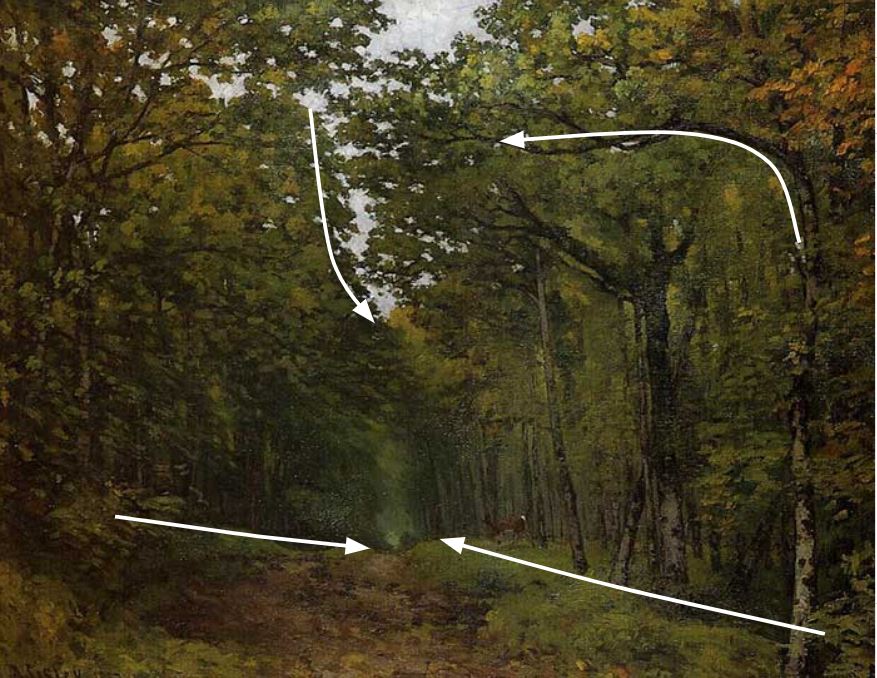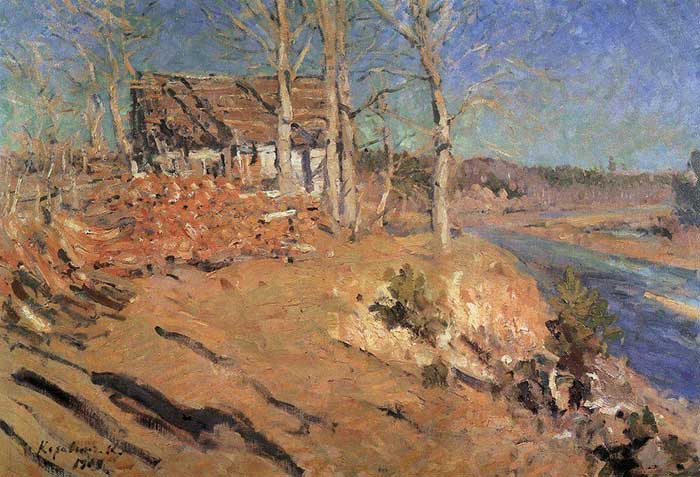Leading lines are one of the most effective and under-utilized composition tools available to artists. Leading lines are essentially lines that lead people through the painting, usually towards points of interest.
These lines can either be created using actual lines in your painting or organically through the arrangement of elements in your painting (for example, the line created by the top of a mountain range in the distance).
There is a strong psychological element to leading lines which makes them such a powerful tool. Our eyes like to follow lines. It is as simple as that. This is powerful in that you can essentially use leading lines to direct people to wherever you want in the painting. In this post, I cover:
- How Can You Utilize Leading Lines in Your Artworks?
- How Not to Use Leading Lines
- Try and Identify the Leading Lines Yourself
- Want to Learn More?
- Thanks for Reading!
How Can You Utilize Leading Lines in Your Artworks?
There are many ways you can utilize leading lines in your artwork. The trick is to use the leading lines to purposefully direct people throughout the painting and towards points of interest. You do not need to boldly direct people straight to your focal point. It could be much more intricate than that.
It is also important not to overdo it. There is beauty in subtlety, and some things are better left to the viewer’s imagination. So do not go and direct every line in your painting toward your focal point. That would be way too obvious.
Instead, use a few lines to gently draw people around the painting and ultimately in the direction of your focal point. People do not want to feel like they are being pushed in a certain direction. You need them to think they arrived there on their own accord.
Claude Monet utilized leading lines in many of his paintings to draw you in and around the paintings. In the painting below, lines are created by the shoreline and the cliff. There is also a subtle line created by the formation of the boats.


There are clear leading lines all throughout the painting below which draw you through to the horizon line.


Sometimes, the leading lines do not need to be clear, like in the painting below by Alfred Sisley. In this painting, the leading lines are created organically by the edges of the trees, the path and from changes in light.


Leading lines are often far easier to demonstrate when architectural objects are involved. In nature, you usually must rely on lines that are created organically through the arrangement of natural elements (such as the line created by a row of trees). But when architecture is involved, you can simply use the lines created by the architecture.


Leading lines do not always need to be subtle. You can use bold strokes of color to direct people throughout your painting as Konstantin Korovin did in this painting.

How Not to Use Leading Lines
As with anything in painting, you need to be careful with how you use leading lines. It is a powerful technique that you want to use to your benefit, not be a detriment.
Here are some common mistakes made with leading lines:
- You lead people out of the painting. The purpose of leading lines is to direct people throughout your painting, generally to points of interest. You do not want to direct people straight out of the painting. This means you should try to avoid lines which directly point to the edges of your canvas.
- You make it too obvious. People do not like being told what to do. You want them to think they arrived at a destination without any influence. Leading lines are often best used as subtle suggestions to gently push people to where you want them to go.
- You do not have enough variance. There is nothing natural about having numerous leading lines which are all the same length, angle and thickness pointing in the same direction at your focal point. Try and mix it up. This will result in a more natural composition.
- You lead people with no purpose. The general purpose of leading lines is to guide people to points of interest in your painting. You should always have a purpose in mind when leading someone through your painting.
Try and Identify the Leading Lines Yourself
In the paintings below, try and identify the leading lines (if any). Observe where the lines take you.
If you are not sure, then relax and just enjoy the painting. Take note of where your eyes are naturally drawn and the lines they seem to follow.






Want to Learn More?
You might be interested in my Painting Academy course. I’ll walk you through the time-tested fundamentals of painting. It’s perfect for absolute beginner to intermediate painters.
Thanks for Reading!
I appreciate you taking the time to read this post and I hope you found it helpful. Feel free to share it with friends.
Happy painting!
Dan Scott

Draw Paint Academy







Hi Dan. Can you please confirm that you received my credit card payment for 24S for you eBook. You asked for a code. Did not know what code you want and then it looked like it went off. FNB credit card visa south africa. Thanks Babre Anne Koch. I AM on your mailing list.
Hi Babre, I will contact you via email regarding this.
Kind Regards
Dan
Thank you, very pleased and helpful. I was just thinking about this.
Thanks Marina!
Dan
What a great article. Even after years of experience, it’s good to be reminded to have a purpose for leading lines.
Appreciate the kind words!
Dan
Hi Dan,
Thank you for this lesson about Leading Lines. It is very interesting and important information for constructing the main subject of the picture and also as you said ” the main purpose is to guide people to points of interest in your painting”. It is very true that artist should always have a purpose in mind when leading someone through painting.
And also very thanks for using my favorite Russian masters as I. Shishkin, I. Repin, K. Korovin and of course Claude Monet. Regards, Larissa
Hi Larissa, thanks for the thoughtful comment!
Dan
Thanks Dan. …..very helpful.
Lois
My pleasure Lois 🙂
Dan
Thanks! This is a really great tutorial. Composition is so important, and these leading lines with example pictures are a wonderful concept. I’ve been reading your blog for a while now and you’re building up a great resource here.
Really appreciate the kind words Ben!
Yes, hopefully I can build this up to be a great resource for those wanting to jump into the world of fine art.
Dan
Love the idea of this fine work of art
Thanks Arthur!
I have just had a problem with leading lines. It was in a painting the lines directed the viewer to a range of trees at the top of the canvas and not to the main subject of two children. I was able to change that line by building up the foreground which led the viewer onto the main subject. Thank you for a very interesting article.
Thank you for a very easy to read article.
Thank you. Reading through your articles, for the first time ,is very exciting and giving me an improved base of understanding ‘words’ used by artists in general.